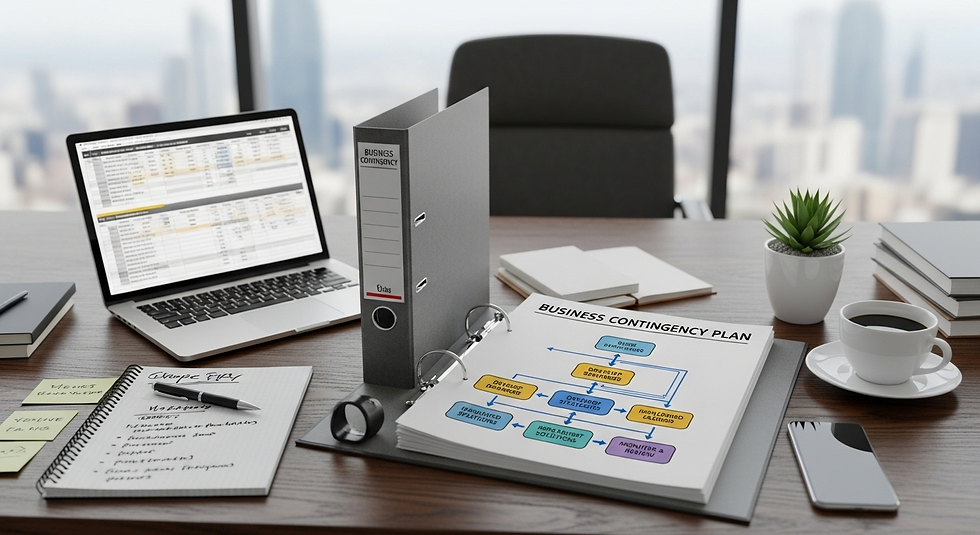5 Critical Elements of Disaster Recovery Every Business Must Know
- rebekahh84
- Jun 26
- 4 min read
Updated: Sep 25

Disasters can happen suddenly and they can interrupt or completely stop business operations within minutes. These disasters can include natural events like
· Floods
· Earthquakes
· Man made issues like cyberattacks or human mistakes.
Businesses face growing risks from both types of disasters.
These unexpected events can lead to data loss and financial setbacks and they can even cause a complete shutdown. This is why every business must have a disaster recovery plan that is well prepared and ready to use.
Disaster recovery helps restore systems and data and it also helps resume business operations quickly when something unexpected happens.
The ability to recover without major losses can determine whether a business survives or fails when the disruption comes from a lightning strike or a malware attack. The following are five critical elements that every business must understand and include in its disaster recovery strategy.
1. Knowing the Types of Disasters Your Business Might Face

Every business must learn about the types of disasters that could occur before making a recovery plan. They need to understand the risks is the first step in building a strong disaster recovery plan because it helps identify the threats that could affect business activities. These threats usually fall into two main groups that are natural disasters and man made disasters.
Natural disasters include earthquakes and wildfires and they also include hurricanes and floods. These events can damage buildings and destroy data centers and they can also make workplaces unusable for long periods of time.
Man made disasters can involve cyberattacks and power failures and they can also include theft and software problems. Human mistakes like deleting files or misconfiguring systems can also cause serious issues.
2. Set Goals That Support Business Continuity

A business must decide how quickly its systems should return to normal with the help of crisis management after a disaster after identifying the risks. This involves setting two key goals that are called recovery time objective and recovery point objective.
The recovery time objective is the longest period a business system can stay offline before major harm happens. A business for for example that sells products online may need to get its website running again within two hours. In contrast, a reporting system for internal use might be able to wait for a full day.
The recovery point objective is the amount of data that a business can afford to lose. This is measured in time and if your recovery point objective is fifteen minutes then your systems must save data often enough so that no more than fifteen minutes of work is lost.
These two goals help you choose the right tools and backup methods and they help keep the disaster recovery plan in line with your business needs.
Is your business ready to face the next crisis with confidence?
Discover how Business Contingency Group can help you build a powerful crisis management solution that keeps your operations running.
3. Build a Backup System That Is Reliable and Secure

Losing important data is often the most damaging part of a disaster. You must have access to secure backups to get your data back if your systems crash because of a cyberattack or if a building is destroyed by fire.
Every business should follow the 3 2 1 rule for backups. This means you should keep three copies of your important data and store them on two different types of storage and keep one copy in a different location such as in the cloud.
Using cloud backups is helpful because they are easy to access and they are stored safely in a different place and they update automatically. However, it is also wise to use local backups in case you need faster recovery.
4. Assigning Roles and Creating a Communication Plan

People can become confused and slow to act when a disaster happens. That is why every recovery plan must include clear roles and steps for communication.
Start by choosing a team that will handle recovery. Each person should know what they are responsible for. One person might restart the systems and another might contact customers and someone else might work with vendors or support staff.
There must also be a plan for communication during an emergency. If email is not working then employees must have access to phones or apps that let them talk to each other. You must also have a way to send messages to your clients. This can include social media or text messages and these communication channels must be reliable and easy to use.
5. Testing the Plan and Keeping It Updated

No disaster recovery plan is useful if it is never tested. A plan that seems perfect on paper might not work in real situations unless it is practiced.
Businesses must run tests at least once a year. These tests can be simple drills where the team talks through the plan or they can be more complex events that simulate a real emergency. During testing, the team should follow each step and look for any problems or delays.
Technology changes over time and business operations may also grow or shift. This means your disaster recovery plan must be updated often.

Conclusion:
Disasters will always remain a part of life for any business. Some may come suddenly like cyberattacks while others like storms may give a short warning. However, what truly matters is how prepared your business is before these events take place.
Your business will become more prepared and more resilient by learning about both natural and man made threats. Disaster recovery is not just about going back to work but keeping your data and your people and your reputation safe. A strong recovery plan gives you confidence that you can keep moving forward no matter what happens.




Comments